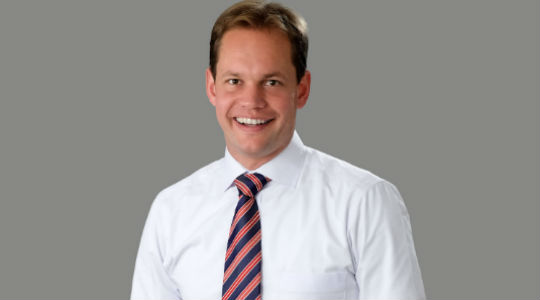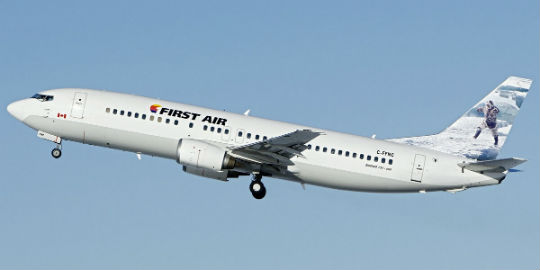Estimated reading time 7 minutes, 52 seconds.

With fleet modernization in full swing at the moment, First Air aims to continue reducing complexities to only two types later this year: Boeing 737-400s and ATR 42s. First Air Photo
The Arctic is probably not the first place most people think of as a vacation destination. However, for the adventurous and seasoned world traveller attracted to wide-open spaces and scenic vistas, the Canadian North has a lot to offer.
First Air, which has been operating as “the airline of the North” for 70 years, is among the stakeholders hoping to foster tourism development in the region—thereby increasing its passenger numbers at the same time.
“The people who visit the Arctic are people who have been to many places around the world, and they now want something else while on holiday,” said Bert van der Stege, vice president, Commercial at First Air. “If you’ve been to Las Vegas three times, if you’ve seen Europe and South America, it’s time for something else.”
There are a lot of beautiful things to see and do in the North. Although the terrain might be frozen and the temperatures low, travellers to the Arctic can experience activities such as bobsledding, ice kayaking, ice fishing and glacier trekking.
Together with its codeshare partners, First Air serves over 30 destinations in Northern Canada from its two hubs in Yellowknife, N.W.T., and Iqaluit, Nunavut. The airline offers non-stop flights from Ottawa, Montreal, Winnipeg and Edmonton, with connecting services to other large metropolitan areas in Canada through interline relationships with Air Canada and WestJet.
“We take quite a few people from the major cities in the (Canadian) South up North, because they want a greater sense of what the North has to offer,” said van der Stege. “Many southerners are interested in the Arctic. In Canada, you only really learn about the North in school, in museums and on TV. There’s something in your own country you haven’t experienced that is worth going to see,” he said.
First Air serves approximately 235,000 passengers per year. In many cases, the airline is an essential service provider, since there is no other means of transportation to most of its destinations. In addition, it carries more than 22 million kilograms (48.5 million pounds) of freight and mail to the northern territories.
“Some of the communities we serve have only 200 residents, but they depend on air transportation for their goods,” explained van der Stege.
Finding efficiences
Originally founded as Bradley Air Services in Ottawa, First Air is now owned by Makivik Corp., an Inuit-owned organization responsible for administering the land claim settlement of the Inuit of northern Quebec.
First Air’s milestone anniversary comes at a time of significant change for the airline. In the last five years, profitable operations have proven to be a challenge for First Air, as market changes and rising operational costs have resulted in posted losses. The company launched a three-year restructuring plan in January 2014, aiming to right-size the airline and its financial ship. This plan included analyzing long-established business practices.
“Along with our legacy came a culture of people doing what they do, because that’s just the way it had always been done,” said van der Stege. “Through our internal change program, we wanted people to question everything we’ve been doing, determine if there’s a better way to do it, and find efficiencies in our operations.”
The first two years of restructuring—2014 and 2015—involved various initiatives to lower the airline’s cost base and improve revenue. As an example, First Air reduced the number of aircraft types it currently operates from seven to four.
With fleet modernization in full swing at the moment, the airline aims to continue reducing complexities to only two types later this year: Boeing 737-400s and ATR 42s.
“From 2010 onwards, First Air was experiencing unsustainable operating losses,” said van der Stege. “Our board could not allow this to continue. It is important to remember that First Air is a business, and as such it requires an adequate return on investment. Running an airline is expensive everywhere, but nowhere near as expensive as in Northern Canada.”

Bert van der Stege, vice president, Commercial at First Air. First Air Photo
Having worked in the airline industry on every continent in the world, van der Stege knows the truth of this statement first-hand. “Jet fuel in the North is about three times as costly as in the South. Gravel runways across the Arctic mean our maintenance costs are much higher than for other airlines. Harsh weather conditions and limited infrastructure lead to high cost when an aircraft diverts; or, if you need another example, just think about de-icing costs.”
Throughout the years of change and restructuring, First Air only terminated one route (from Rankin Inlet to Repulse Bay in Nunavut), with personnel levels remaining consistent, mainly because of third-party work it now performs for others.
However, the turnaround wasn’t easy. The strategy included codesharing with Calm Air and Canadian North, which initially met with scepticism from some customers, politicians and other stakeholders.
“Canada’s North is simply too small to have several airlines flying wing-to-wing with, at best, half-empty aircraft and all incurring operating losses,” said van der Stege. “Largely unknown to Northern Canada, codesharing is an industry practice that allows for improved efficiencies. The strategy helped achieve more sustainable route results, while the alternative would have been further reductions in service. Without codesharing, several northern communities would no longer have been part of our network.”
After five years of losses, First Air posted a profit for 2015 and achieved its objective of a positive cash flow, but van der Stege said, “We’re still not where we want to be. We will never stop looking for better ways of doing what we do.”
Fleet modernization
This year, First Air invested heavily in fleet modernization. A $110 million program is underway, with new and replacement aircraft entering the fleet, including a new Boeing 737-400 all-passenger aircraft and an additional Boeing 737-400 combi.
A first in Canada, the airline introduced the ATR 42-500 aircraft in February 2016, as a replacement for its aging ATR 42-300 series.
Modernizing the fleet is a key component of the three-year turnaround plan. “We are excited to invest in a more modern fleet of aircraft, well suited for the North,” said van der Stege. “The new ATR 500 series offers improved seating and comfort and has better performance. The upgraded cabin allows for better seating options, as well as an increase in payload capacity.”

A first in Canada, First Air introduced the ATR 42-500 aircraft in February 2016, as a replacement for its aging ATR 42-300 series. Mark Taylor Photo
The first ATR 42-500 to enter the First Air fleet is a 42-seat, all-passenger aircraft with a generous seat pitch, perfectly suited for the harsh weather conditions in the Canadian North and able to operate on gravel runways. The aircraft will service the two daily Yellowknife-Hay River flights, as well as Fort Simpson and selected Kitikmeot routes in Nunavut.
The second all-passenger ATR 42-500 will be based in Iqaluit, the airline’s hub for the Eastern Arctic. First Air will also be introducing several ATR 42-500 combi aircraft later this year, with a fixed configuration for passengers and cargo.
First Air is well known for its expertise in ATR operations. Besides flying ATRs, the airline runs the largest ATR maintenance and engineering facility in Canada, performing heavy maintenance work for third parties.
First Air currently owns 12 ATRs. The new 500 series will be used to expand the fleet, and will gradually replace the 300s on scheduled routes. Like all First Air aircraft, the new ATR 42-500s are also available for exclusive charters. Along with being a large employer in the North, First Air is also a strong community supporter. “We’re very proud of being ‘the airline of the North’ and of being around for 70 years, making a real difference in people’s lives,” concluded van der Stege.

